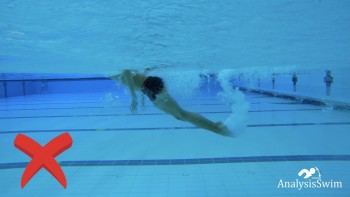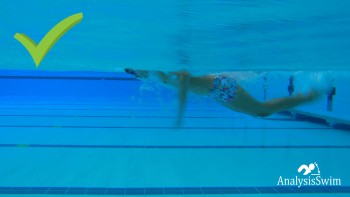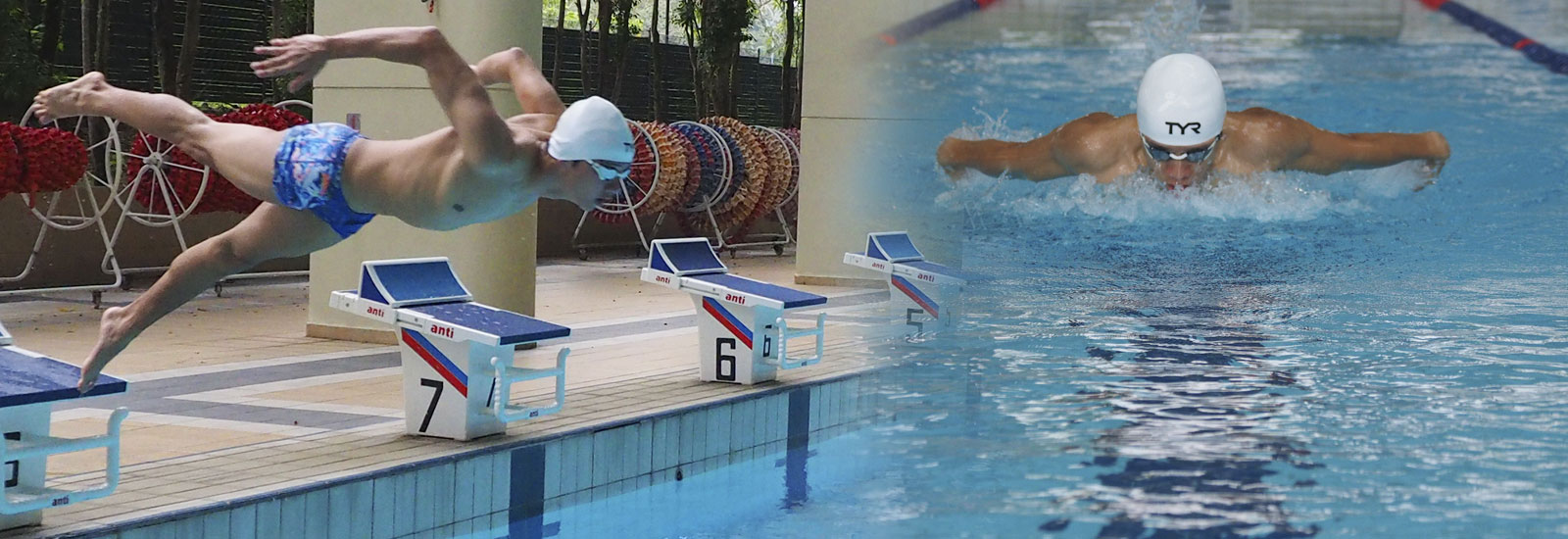Tips to correct the most common mistakes in Butterfly
Body position
Butterfly differs in body position from other swimming styles. In a Butterfly, the body makes an undulating movement up and down, reminding us how a dolphin moves. During pull and kick, an athlete should not excessively descend under the water and rise out of the water, and this will lead to a sizeable frontal resistance in the water. Less water resistance will allow you to swim faster and use less power.
What reasons can cause the incorrect position of the body?
- The work of the arms and legs is not synchronised and is done separately
- Late breath during the return of the hands
- Bad footwork
- Arms and legs sink very deep under the surface of the water
- Pelvis dropped very deep throughout the pull or kick
- During the stroke, rotation of the body to the right or left side
Wrong:

Here’s what to do instead
- The whole body of the swimmer as a whole moves along a wave trajectory
- The wave movement begins from the head through the chest. It is transmitted to the middle part of the body and the pelvis, and then from the pelvis to the hips, legs and feet
- Body angle of attack can vary from – 20 degrees to + 20 degrees during the Propulsive phase and Recovery phase of the pull
Correct:

Tips:
While gliding, do not relax your back; this will help you to be in a streamlined position
While gliding, looks down and extend your arms in front to create less resistance
Keep your pelvis close to the surface of the water; this will help you to stay in a streamlined position
Drills Related:
Front float
Streamline float
Progression Floating Star Version 1
Mermaid dolphin kick with snorkel
Breathe
Inhalation is the primary and essential element in a dolphin. The most important thing is to inhale as quickly as possible, so it’s not affected the movement of the arms and legs. A good breath will help you float better and, prevent muscle fatigue, allow you to swim long distances.
What reasons can cause the incorrect position of the breath?
- During inhalation, high position of the head above the surface of the water
- During exhalation, the low position of the head underwater during exhalation
- Inhalation is very late and begins when the arms are already crossing the line of the shoulders
- Exhalation above the surface of the water
- Inhale and exhale only through the nose
Wrong:

Here’s what to do instead
- Head rises from the water and begins to inhale. The chin is at the water’s surface, and the face is directed forward
- The inhale ends after the first half of the sweeping of hands over water. Then the head is lowered face into the water, and the hands complete the recovery
- The athlete exhales through the mouth and nose and continues throughout the rest of the cycle
Correct:

Tips:
While inhaling, inhale as quickly as possible
Drills Related:
Butterfly pull while kicking freestyle with flippers
Pull
The arm stroke in the dolphin is the main element for moving the body forward. An essential role in the stroke is played by the physiological capabilities of the swimmer, the length of his arms, the strength of the arms and the coordination between the body and legs. With a good pull with your arms when swimming butterfly, you will be able to increase the speed by up to 70-80%.
What reasons can cause incorrect movement of the pull?
- During the pull phase, the elbow is facing down
- During the stroke, the palms are facing down
- Stroke with straight arms
- Arms open wide during entry
- Alternately movements of the arms during pull or recovery
- The pull ends at the navel line or earlier
Wrong:


Here’s what to do instead
- During the pull phase, hands are swept slightly, and arms are bent with the hand and forearm the leading, supporting movement relative to the elbow. Before reaching the shoulder line, arms and forearms change direction movements, move inward-downward-backwards
- When the arms cross the shoulder line underwater while the palm and the forearms are facing backwards, the swimmer continues a strong pull with the head and torso moving out of the water
- The arms, continuing a powerful backward movement, gradually straighten in the elbow joints. Make an end of the pull behind the hips line
- In the final part of the pull stroke, the hands move back and out for recovery
- The recovery phase of arms begins with the shoulder and elbow coming out of the water, sweeping through the sides forward with straight, relaxed hands, while middle fingers enter first, with a slightly high elbow above the water
Correct:


Tips:
Butterfly recovery movement is performed with a sweep through the sides forward with straight, relaxed hands, and the shoulders slight rise above the water. Make a quick recovery
By the end of the phase recovery, the hands are rotated with the palms down, and the elbows should be turned so that the fingers touch the water first
The arms should stretch out in front of the body above the water surface
During the pull, keep a high elbow
Drills Related:
Pull and Stop Butterfly
High elbow while lying on the edge of the pool
Butterfly drill 2+2+2
Whirlpool
Kick
The main task of kicking is to balance the work of the arms, torso and legs so that the body is in a streamlined position for as long as possible. The streamlined part of the human body in the water allows you to minimise the resistance in the water and achieve maximum speed. Do not forget that steady and rhythmic kicking helps you to move your body forward and will help the quickly return your hands above the water.
What reasons can cause incorrect movement of the kick?
- Very deep kick
- During kick very wide open legs
- During a kick, the knees sink deep down
- During the catch of water, the feet are above the surface of the water
- Flutter kick or Breaststroke kick
Wrong:


Here’s what to do instead
- All up and down movements of the legs must be simultaneous
- During the kick, the feet slightly turned inward
- When the shins and feet approach the horizontal position, the pelvis and hips begin to rise to the water’s surface. Further, the pelvis and hips go to the water’s surface, legs quickly straighten in knee joints and, with acceleration, perform a whip down movement
Correct:


Tips:
The Propulsive phase (kick-down) is considered completed. The moment when the buttocks appear on the surface of the water and the legs straighten entirely in the knee joints
Kick steady and fast
Drills Related:
Butterfly dolphin kick while holding the edge of the pool
Backward butterfly dolphin kick
Superman dolphin kick with Fins + Snorkel

